Maryland is a haven for bird enthusiasts, and its blue bird species are particularly captivating. The state is blessed with a diverse geography that includes mountains, forests, rivers, and a share of the Chesapeake Bay, offers a unique habitat for a myriad of bird species. These beautiful creatures adorn the landscapes of Maryland with their vibrant hues and melodious songs.
In this guide, we have carefully curated a list of 12 stunning blue birds that you can spot in the state, complete with a free photo guide to help you identify them during your birdwatching adventures. Let’s embark on a journey to discover the blue wonders of Maryland’s avian world!
Blue Birds Found In Maryland
The geographical diversity of Maryland is a key reason for its rich avian population. From the Appalachian Mountains in the west to the Atlantic Coastal Plains in the east, the state’s varied landscapes provide a wide range of habitats for different bird species.
The Chesapeake Bay, the largest estuary in the United States, attracts a host of migratory and aquatic birds. The state’s mix of deciduous and coniferous forests, wetlands, and open fields make it a suitable home for various species of birds, including an impressive array of blue birds.
Eastern Bluebird
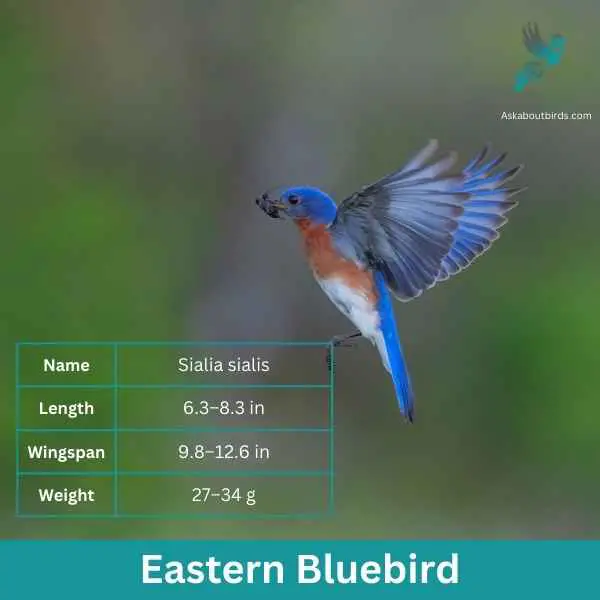
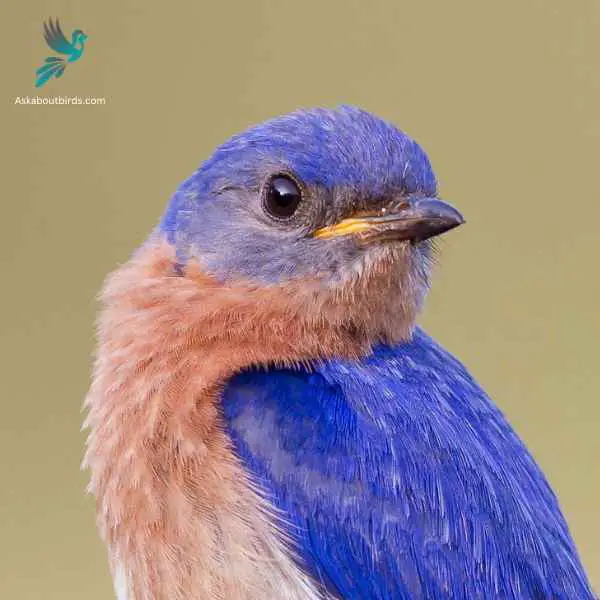
| Feature | Measurement |
|---|---|
| Scientific Name | Sialia sialis |
| Length | 6.3–8.3 in |
| Wingspan | 9.8–12.6 in |
| Weight | 27–34 g |
The Eastern Bluebird (Sialia sialis) is a small thrush found in open woodlands, farmlands, and orchards, and is recognized for its vibrant blue and red coloration. Male Eastern Bluebirds are dazzling with bright blue upperparts and a rusty or brick-red throat and breast, while females, though less colorful, still offer a similar pattern. The bird is native to North America and is commonly seen east of the Rockies, from Canada to the Gulf States and southeastern Arizona to Nicaragua.
Eastern Bluebirds feed on insects, wild fruit and berries. They have a gentle nature and are often seen perched alone or in small groups in the open, scanning the ground for prey. They are cavity nesters and will use old woodpecker holes or birdhouses if they are the right size.
Blue Jay

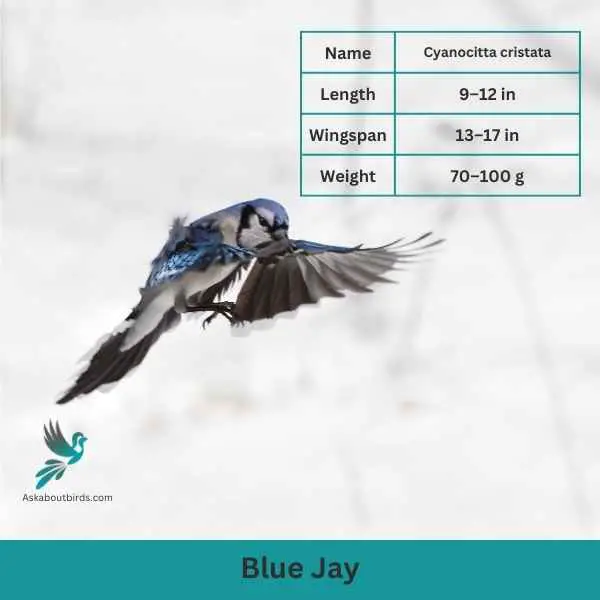
| Feature | Measurement |
|---|---|
| Scientific Name | Cyanocitta cristata |
| Length | 9–12 in |
| Wingspan | 13–17 in |
| Weight | 70–100 g |
The Blue Jay is a vibrant and easily recognized bird, known for its intelligence, distinctive calls, and bold behavior, commonly found throughout the eastern and central United States.
Appearance: The Blue Jay sports a striking blue upper body with white and black markings. Its face has a pronounced white patch with a black necklace that runs across the throat and around the head. The bird also features a pronounced blue crest, which can be raised or lowered, and its wings and tail are brightly colored with black bars and white tips.
Diet: Blue Jays are omnivores. Their diet consists primarily of seeds, nuts, especially acorns, fruits, and small insects. They’ve also been known to eat eggs or nestlings of other birds occasionally. Blue Jays often store food items in caches to eat later.
Reproduction: Blue Jays are monogamous birds that form long-lasting pair bonds. They typically build their nests in trees or large shrubs, constructing them from twigs, grass, and sometimes using mud as a binder. The female lays a clutch of 3 to 6 eggs, which are pale blue or sometimes white with brown speckles.
Indigo Bunting


| Feature | Measurement |
|---|---|
| Scientific Name | Passerina cyanea |
| Length | 4.5–5.1 in |
| Wingspan | 7.1–9.1 in |
| Weight | 11.2–21.4 g |
The Indigo Bunting is a strikingly vibrant songbird, often hailed for its brilliant blue plumage and melodic song that graces woodlands and meadows during the warmer months.
Appearance: Males are renowned for their bright indigo blue feathers, which can appear darker in certain lights. Females and juveniles, on the other hand, are brown with subtle hints of blue on their wings and tail. The species lacks the vibrant streaking or spotting commonly found in many other songbirds.
Diet: Indigo Buntings primarily subsist on seeds, especially during non-breeding seasons. During the breeding season, they also consume a variety of insects such as beetles, caterpillars, and spiders, providing essential protein for their growing chicks.
Reproduction: Indigo Buntings build their nests close to the ground in shrubs or low tree branches. These nests, crafted meticulously with grasses and other plant materials, cradle clutches of typically 3 to 4 eggs. After hatching, the young are fed by both parents until they’re ready to fledge.
Blue-winged Warbler
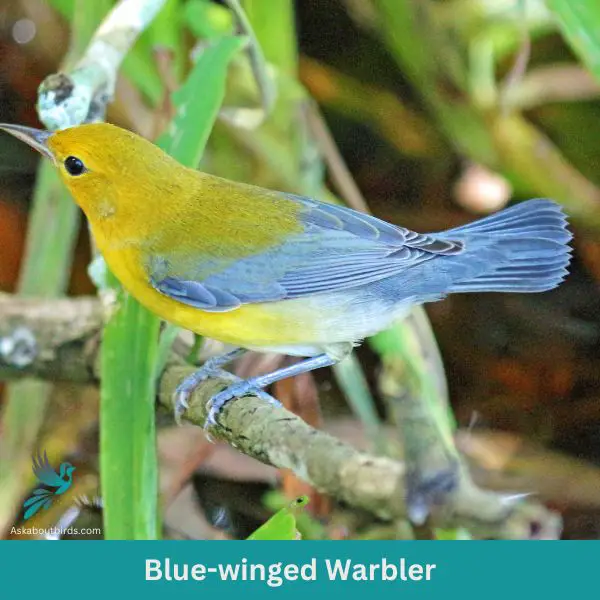
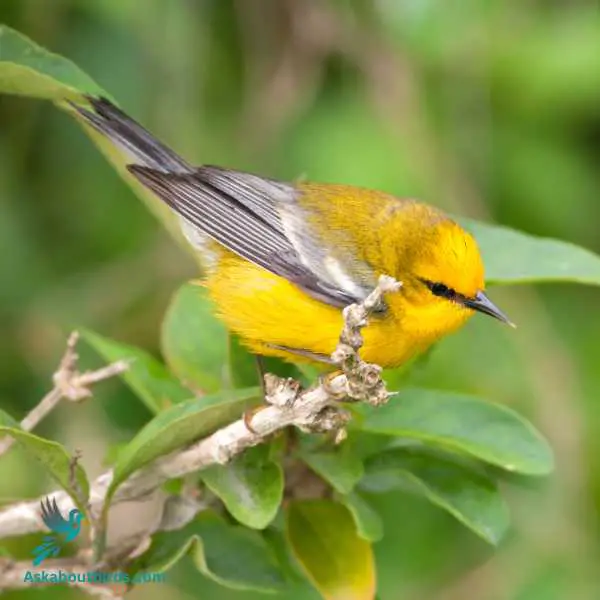
| Trait | Blue-winged Warbler |
|---|---|
| Scientific Name | Vermivora cyanoptera |
| Length | 4.3-4.7 inches |
| Wingspan | 6.7-7.5 inches |
| Weight | 0.3-0.4 ounces |
The Blue-winged Warbler is a vibrant songbird that stands out with its lemon-yellow coloring and buzzing song.
Appearance: This warbler displays a brilliant yellow body contrasted by blue-gray wings and a slim, black line through the eyes. The wings also feature two white wing bars.
Diet: The diet of the Blue-winged Warbler primarily consists of insects and spiders. They actively forage in shrubs and low trees, picking off their prey from the foliage.
Reproduction: Blue-winged Warblers build their nests on or near the ground, using grasses and other fine materials. The female lays a clutch of 4-6 eggs, which she incubates.
Cerulean Warbler
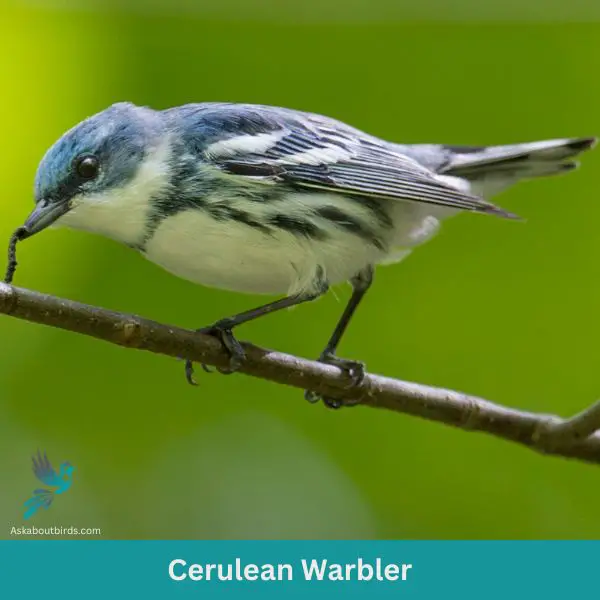
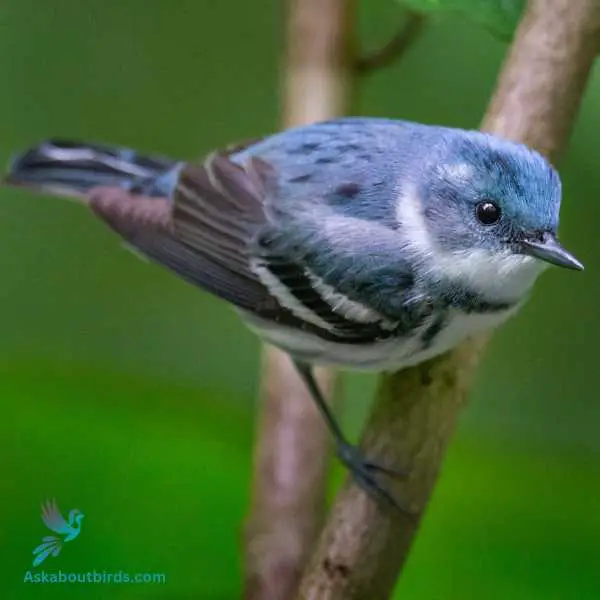
| Trait | Cerulean Warbler |
|---|---|
| Scientific Name | Setophaga cerulea |
| Length | 4.5 inches |
| Wingspan | 7.9-8.7 inches |
| Weight | 0.3-0.4 ounces |
The Cerulean Warbler is a striking songbird known for its sky-blue plumage and flitting movements in the forest canopy.
Appearance: Males boast a vibrant cerulean blue color on their upperparts, with streaked underparts, and a black necklace. Females have a more subdued bluish-green hue and lack the prominent black markings seen in males.
Diet: The diet of the Cerulean Warbler is predominantly made up of insects and spiders. They actively forage high in the treetops, gracefully maneuvering through leaves and branches.
Reproduction: Cerulean Warblers nest in the upper branches of tall deciduous trees. The female weaves a shallow cup-shaped nest and lays a clutch of 3-5 eggs.
Black-throated Blue Warbler

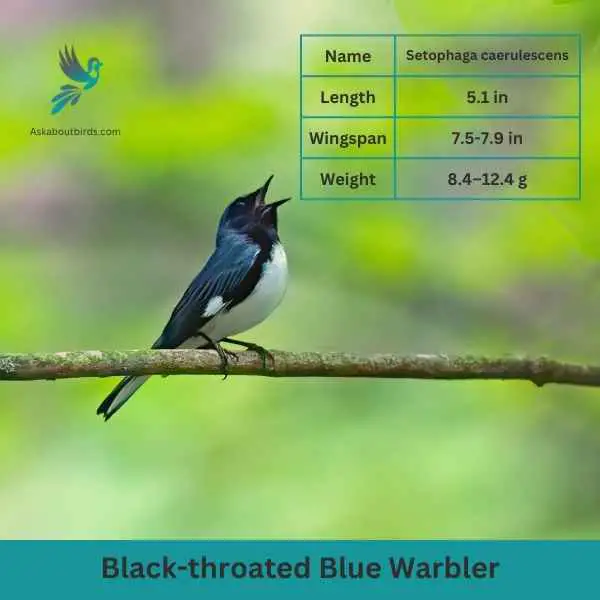
| Feature | Measurement |
|---|---|
| Scientific Name | Setophaga caerulescens |
| Length | 5.1 in |
| Wingspan | 7.5-7.9 in |
| Weight | 8.4–12.4 g |
The Black-throated Blue Warbler is a small migratory bird that breeds in the eastern United States and parts of Canada. The male Black-throated Blue Warbler displays a striking appearance with deep blue plumage on its upperparts, contrasting sharply with a black throat and a white belly. Females, on the other hand, have more muted colors, featuring grayish-olive plumage with a lighter throat.
These warblers prefer deciduous and mixed woodlands, where they forage actively for insects and spiders. They have a slender bill, which they use to extract prey from foliage and tree bark. During the breeding season, males perform courtship displays, showcasing their vibrant plumage and singing a high-pitched song to attract mates.
Black-throated Blue Warblers are known for their long-distance migration. They spend their winters in the Caribbean and Central America, where they inhabit various forested habitats. They construct cup-shaped nests in trees or shrubs, often placing them close to the ground.
Blue-gray Gnatcatcher
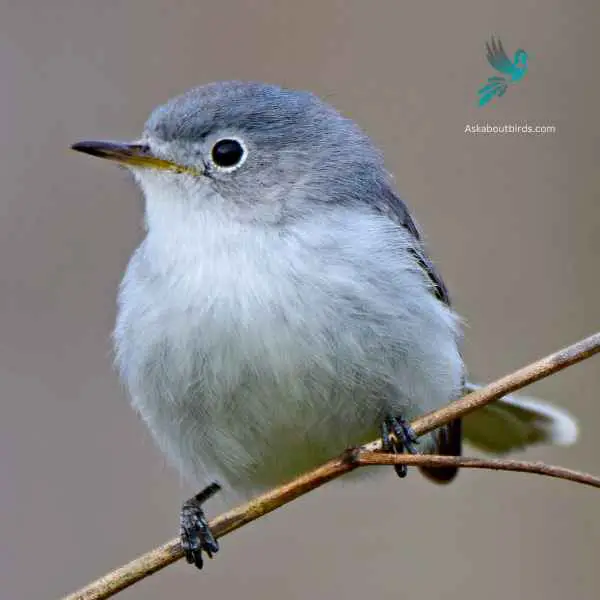
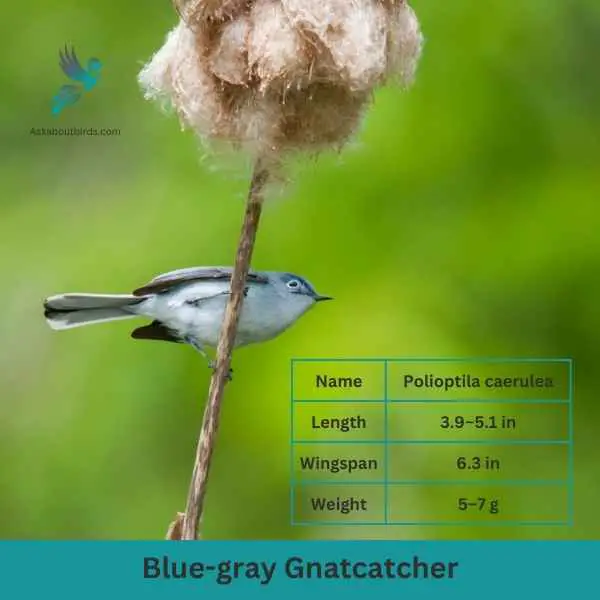
| Feature | Measurement |
|---|---|
| Scientific Name | Polioptila caerulea |
| Length | 3.9–5.1 in |
| Wingspan | 6.3 in |
| Weight | 5–7 g |
The Blue-gray Gnatcatcher is a petite, active bird, frequently observed flitting about treetops, emitting its distinctive high-pitched calls as it moves agilely through the branches.
Appearance: This bird exhibits a predominantly blue-gray plumage with a subtle white eye ring and long, slender tail feathers. The tail has distinctive black and white edging, with the males sometimes showing a faint black line on their forehead during the breeding season.
Diet: Blue-gray Gnatcatchers primarily feed on small insects and spiders. They’re adept hunters, foraging actively among foliage and even catching insects in mid-air.
Reproduction: These birds weave compact, cup-shaped nests on tree branches using plant materials, spider webs, and lichen. The exterior of the nest often matches the tree bark, making it well camouflaged. Inside, the female lays a clutch of 3 to 5 blue or greenish eggs, which she incubates.
Belted Kingfisher

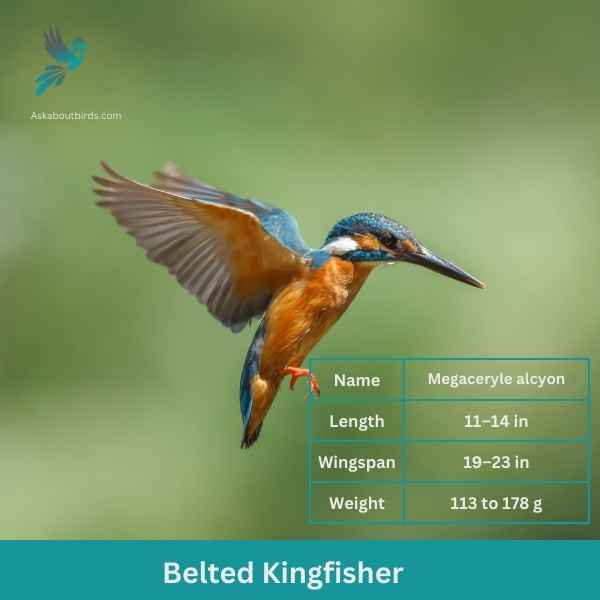
| Feature | Measurement |
|---|---|
| Scientific Name | Megaceryle alcyon |
| Length | 11–14 in |
| Wingspan | 19–23 in |
| Weight | 113 to 178 g |
The Belted Kingfisher is a distinctive and easily recognizable bird, frequently observed near water bodies, where it can be seen diving headfirst to catch prey.
Appearance: Sporting a prominent crest, the Belted Kingfisher has a slate blue-gray upper body and white underparts. Males possess a single blue band across their white chests, while females have an additional rufous band, making them one of the few bird species where females are more brightly colored than males. Their bill is long, sharp, and dagger-like.
Diet: As expert fishers, Belted Kingfishers mainly prey on small fish, but they’ll also consume crustaceans, insects, and amphibians. They’re known for their hunting tactic of hovering over water, spotting their prey, and then diving swiftly to snatch it.
Reproduction: Belted Kingfishers nest in burrows which they excavate in sandy or earthen banks, usually adjacent to water. The tunnel can be anywhere from 3 to 6 feet long, ending in a chamber. Within this chamber, the female lays a clutch of 5 to 8 white eggs.
Tree Swallow
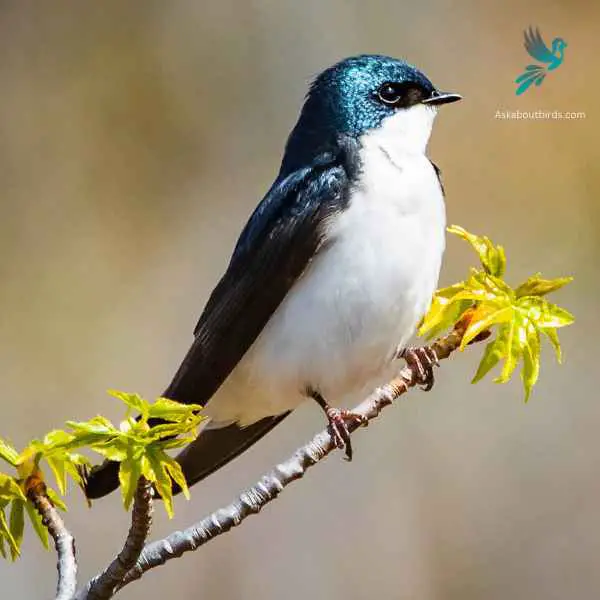
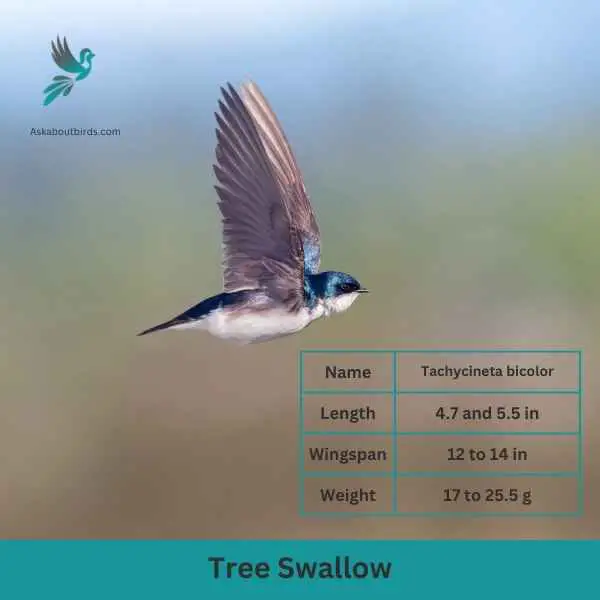
| Feature | Measurement |
|---|---|
| Scientific Name | Tachycineta bicolor |
| Length | 4.7 and 5.5 in |
| Wingspan | 12 to 14 in |
| Weight | 17 to 25.5 g |
The Tree Swallow is a graceful and agile bird, best recognized for its iridescent blue-green upperparts and sweeping flight patterns over open fields and water.
Appearance: The Tree Swallow is sleek with a streamlined body. The upperparts shine with a blue-green iridescence while the underparts are white. They possess long, pointed wings and a slightly forked tail, aiding in their agile flight.
Diet: Tree Swallows primarily feed on flying insects, skillfully catching them mid-air. During colder months when insects are scarce, they can switch to a diet of berries, particularly those of the bayberry, which other birds might find hard to digest.
Reproduction: Tree Swallows are cavity-nesters, typically choosing natural holes in trees or using bird boxes. They line their nests with feathers, creating a soft environment for the eggs. The female will lay a clutch of 4 to 7 white eggs.
Barn Swallow


| Feature | Measurement |
|---|---|
| Scientific Name | Hirundo rustica |
| Length | 6.5–7.5 in |
| Wingspan | 12.5–13.5 in |
| Weight | 16–22 g |
The Barn Swallow is a sleek, agile bird renowned for its graceful flight patterns and iconic forked tail, often seen darting over fields and water bodies in search of flying insects.
Appearance: Barn Swallows have deep blue, almost iridescent, upperparts and a rufous to tawny underbelly. Their distinctively forked tail and long wings give them a streamlined look. Both males and females have a similar appearance, though males often exhibit slightly brighter colors and a deeper fork in the tail.
Diet: Barn Swallows feed primarily on flying insects, which they catch in mid-air during their agile and acrobatic flights. Their diet includes flies, beetles, moths, and other small flying insects.
Reproduction: Barn Swallows are known for building their mud nests on man-made structures, particularly barns, bridges, and eaves. The nest is cup-shaped and made from mud pellets, often lined with feathers. The female lays a clutch of 4 to 6 eggs.
Purple Martin
Scientific Name: Progne subis
Length: 7.5-9.1 in (19-23 cm)
Wingspan: 15.3-16.1 in (39-41 cm)
Weight: 1.9-2.3 oz (55-65 g)
The Purple Martin is a popular and widely recognized bird species, known for its acrobatic flight and social behavior.
Appearance: Purple Martins have a dark, glossy purple-blue plumage. Males are almost entirely dark purple while females and young birds have a lighter, greyish belly and throat.
Diet: The diet of Purple Martins primarily consists of flying insects such as beetles, flies, dragonflies, and moths. They catch their prey in mid-air while flying.
Reproduction: Purple Martins nest in colonies, often using artificial nest boxes provided by humans. The female typically lays a clutch of 4 to 6 white eggs, and both parents participate in incubating the eggs and feeding the chicks.
Where to Spot Maryland’s Blue Birds
Maryland is a haven for birdwatchers, with its varied landscapes providing a home for a diverse range of bird species. Here are some of the best locations in the state to observe a variety of birds, particularly those with blue plumage:
- Blackwater National Wildlife Refuge: Located on the Eastern Shore of Maryland, this refuge is a critical stopover point for migratory birds and offers a habitat for a wide variety of bird species, including the Blue-winged Teal and the Indigo Bunting.
- Catoctin Mountain Park: Situated in the Appalachian Mountains, this park provides an ideal environment for forest-dwelling birds such as the Eastern Bluebird and the Cerulean Warbler.
- Patuxent Research Refuge: This is the nation’s only national wildlife refuge established to support wildlife research. With its diverse habitats, you can spot a variety of bird species, including the Blue Jay and the Belted Kingfisher.
- Assateague Island National Seashore: This barrier island on the Atlantic coast is a great spot for observing shorebirds and migratory species, including the Blue Grosbeak.
- Gunpowder Falls State Park: With over 18,000 acres of varied terrain, this park is an excellent location to observe a wide array of bird species, including the Wood Duck, which exhibits bright blue plumage on its wings.
| Neighboring States | Best Spots for Blue Birds |
|---|---|
| Pennsylvania’s Blue Birds | 1. Presque Isle State Park 2. Hawk Mountain Sanctuary 3. Middle Creek Wildlife Management Area |
| Virginia’s Blue Birds | 1. Shenandoah National Park 2. Chincoteague National Wildlife Refuge 3. Great Dismal Swamp National Wildlife Refuge |
| West Virginia’s Blue Birds | 1. Canaan Valley National Wildlife Refuge 2. New River Gorge National River 3. Coopers Rock State Forest |
| Delaware’s Blue Birds | 1. Bombay Hook National Wildlife Refuge 2. Prime Hook National Wildlife Refuge 3. Cape Henlopen State Park |
FAQs on Blue Bird Species Found in Maryland
What is the difference between little blue herons and great blue herons?
Little blue herons and great blue herons are two separate species of blue herons found in North and South America. The little blue heron is a small to medium-sized bird with a dark blue plumage, whereas the great blue heron is a large bird with a bluish-gray body, a white head with a black cap, and bright yellow eyes. Both species can be found in similar habitats, such as wetlands, marshes, and the shores of lakes and rivers. However, the great blue heron has a more widespread distribution, being found from southern Canada to northern South America, while the little blue heron is mostly found in the southeastern United States, Mexico, and Central America.
What are the main characteristics of the white-breasted nuthatch?
The white-breasted nuthatch is a small bird found in deciduous forests in the eastern half of North America. It has a distinctive appearance with a white face and chest, a bluish-gray back, and chestnut-colored wing bars. It also has a slightly hooked bill and short legs. This bird is known for its ability to climb down trees headfirst, a unique behavior among small birds. It feeds on seeds and insects, and sunflower seeds are a favorite food when they visit bird feeders. The white-breasted nuthatch is a vocal species, often heard before it is seen.
What are the key features of Indigo Bunting?
Indigo Bunting is a small bird with a bright blue color that makes it one of the blue beauties of the bird world. The males display a royal blue plumage during the breeding season, while females and juveniles exhibit a greenish-gray coloration. They are found across eastern North America, as indicated in the indigo bunting range map, and migrate to southern Florida and Central America during winter. Their diet consists mostly of insects and seeds. The indigo bunting nests in scattered trees and shrubs, usually laying pale blue eggs.
What are the characteristics of Tree Swallows?
Tree swallows are small, blue-colored birds with a bright blue color on the upper parts and white below. They are a widespread species, found in the northern United States and Canada, as shown in the barn swallow range map. These birds prefer to nest in tree cavities, old woodpecker holes, or birdhouses. They mostly eat insects caught in flight but will occasionally eat berries and seeds. Tree swallows breed in the northern United States and Canada, and their breeding grounds are often located near water bodies, such as lakes or rivers. During the non-breeding season, they form large flocks and migrate to the southern parts of North America.

